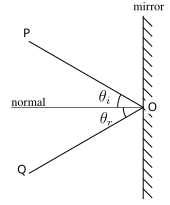Let us do a quick activity before we move ahead with the lesson. Close your eyes for 10 seconds and count to 10; now when you open your eyes again, what do you observe? Do you observe all the things around you? What are the phenomena that allow you to see things around you? Does the phenomena Reflection of Light have anything to do with this? Let us know more about it.
Suggested Videos
What is Reflection of Light?
When a ray of light falls on any object (polished, smooth, shiny object), light from the object bounces back those rays of light to our eyes and this phenomenon is known as “Reflection” or “Reflection of Light”.
This phenomenon is what enables us to look at the world around us and is based on the property that light travels in a straight line. For example, twinkling of stars or light reflected by a mirror.
-

- (Source: Wikipedia)
Laws of Reflection

In the diagram given above, the ray of light that approaches the mirror is known as “Incident Ray”. The ray that leaves the mirror is known as “Reflected Ray”.
At the point of incidence where the incident ray strikes the mirror, a perpendicular line is drawn known as the “Normal”. This normal is what divides the incident ray and the reflected ray equally and gives us the “Angle of Incidence” (Qi) and “Angle of Reflection” (Qr).
Hence the above information gives us the “Laws of Reflection of Light” which state that :
a. The angle of incidence is equal to the angle of reflection.
b. The incident ray, the normal and the reflected ray, all lie in the same plane.
Learn more about Reflection of Light by Spherical Mirrors.
Types of Reflection :
There are majorly two types of reflection :
a. Specular/ Regular reflection
b. Diffused/ Irregular reflection
Browse more Topics under Light Reflection And Refraction
- Spherical Mirrors- Terminology and its types
- Image Formation by Spherical Mirrors
- Mirror Formula and Magnification
- Refraction and Refractive Index
- Spherical Lenses
a. Specular/Regular reflection :
Specular/Regular reflection is a mirror-like reflection of rays of light. Here the rays of light which are reflected from a smooth and shiny object such as a mirror, are reflected at a definitive angle and each incident ray which is reflected along with the reflected ray has the same angle to the normal as the incident ray. Thus, this type of phenomena causes the formation of an image.
-

- (Source: Wikipedia)
Learn how is Image formed in Spherical Mirror here.
b. Diffused/Irregular reflection:
Diffused/Irregular reflection is a non-mirror-like reflection of light. In this type of reflection rays of light that hit an irregular object with a rough surface, are reflected back in all directions. Here, the incident ray which is reflected along with reflected ray doesn’t have the same angle to the normal as the incident ray.
Thus, this type of reflection doesn’t form an image.

(Source: Wikipedia)
Image Formation by a Plane Mirror
Let us take a mirror MM’ as shown in the diagram given above. Let us suppose an object AB of size ‘h’ on the left-hand side of the mirror at a distance ‘u’.
An incident ray of light AP from point A of the object AB falls on the mirror MM’ at point P. This incident ray AP is reflected back in the same path PA. Another ray OC falls on the mirror MM’ at a point O and is reflected along the path OC. Now, since reflected rays PA and OC are diverging and therefore cannot meet each other in front of the mirror, hence we extend these rays PA and OC behind the mirror by dotted lines. On extending these rays behind the mirror, we see that these rays meet at point A’ at a distance V’. Therefore A’ is the virtual image of point A of the object AB.
Similarly, a virtual image of point B will be formed behind the mirror as B’ from the incident rays BO and BE.
Now, to get a complete image of the object AB, we join point A and B to point A’ and B’ by a dotted line. In doing so, we find that the image A’B’ being formed is virtual, erect and of the same shape and size as the object AB; thereby giving us the characteristics of images formed by the plane mirror.
Learn more about the Laws of Reflection of Light in detail.
Characteristics of Images formed by Plane Mirror
a. Images formed by a plane mirror are “Always Virtual”.
b. Images formed by a plane mirror are “Erect/Upright”.
c. Images formed by a plane mirror are of “same shape and size” as that of an object.
Solved Example for You
Q. A ray of light strikes a reflective plane surface at an angle of 42o with the surface.
a. Find the angle of incidence.
b. Find the angle of reflection.
c. Find the angle made by the reflected ray and the surface.
d. Find the angle made by the incident and reflected rays.
Sol: We’ll use a diagram given below to answer the question:

a. Angle of Incidence (Qi)= 900-420= 480
b. Angle of Reflection (Qr)= (Qi)= 480
c. x = 900-Qr = 900-480 = 420
d. Qi + Qr = 480 + 480 = 960








Leave a Reply